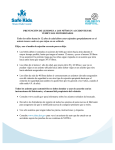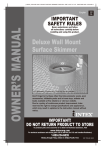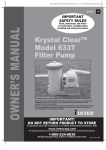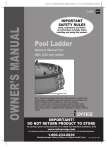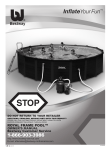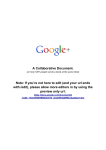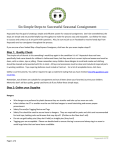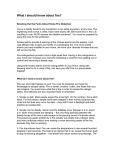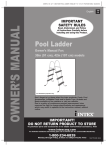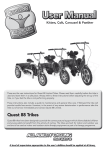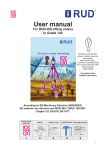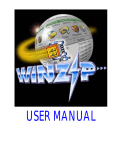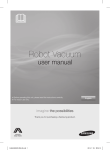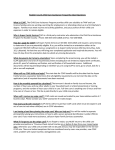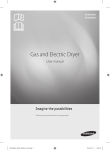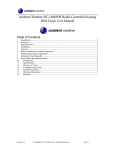Download baby-proofing the home car seat safety trust us for safety
Transcript
TRUST US FOR SAFETY Dear Valued Guest, We know the trust you place in our company to ensure we are doing everything possible to keep children safe and out of harm’s way. This includes offering the products and resources in our Toys“R”Us and Babies“R”Us stores that allow parents and caregivers to create a safe environment for children – whether on the road, at home or at play. As part of our ongoing commitment to keeping kids safe, we work with leading safety organizations to provide you with valuable tools to prevent accidents and injuries. This brochure is a compilation of some of the most important baby safety information we have developed in partnership with the Home Safety Council and Safe Kids Worldwide. Included are tips on babyproofing the home, securing children while on the road, creating a safe sleep environment and preventing playtime injuries. Also featured is a checklist of essential safety products to safeguard kids against potential dangers in the home. We hope you will find this easy-to-use guide an important resource in keeping your children safe at home and on-the-go. We encourage you to visit our dedicated Safety website, Toysrus.com/Safety, for additional tips on preventing home-related and other childhood injuries, as well as the most up-todate information on child and product safety. CAR SEAT SAFETY All Car Seats • Every state in the U.S. enforces the use of car seats for infants, and many hospitals won’t let you drive away with your newborn without one. • Every child on every ride must use a car seat, booster seat or safety belt that‘s right for his or her weight and height. • Follow manufacturers‘ instructions for car seats, booster seats and vehicle safety at all times. • Install car seats using a locked vehicle safety belt or LATCH system. Read and follow all labels and instructions. • Never use car seats purchased from yard sales, secondhand stores or flea markets. • Never place a rear-facing car safety seat in the front passenger seat. All children should be seated away from front passenger airbags. • All children under age 13 must ride in a back seat. What You Need to Keep Baby Safe and Sound 1 1 window blind cord wind-ups 2 Infant Have an expert check your baby’s seat for proper installation at a Safe Kids event. Find one near you at www.safekids.org. Toddler Sincerely, Bigger Kids Infant Car Seats •Use a rear-facing car seat until your child is at least one year old and 20 lbs. Use your rear-facing car seat longer if the seat has higher weight/height limits. •Put harnesses through the slots so they are even with or below the infant‘s shoulders. Be sure the harness is tight, so you can‘t pinch extra webbing at the shoulder. •Use your baby‘s car seat rear-facing and semi-reclined no more than 45 degrees, so the baby‘s head stays in contact with the seat and the baby‘s airway stays open. Read the car seat instructions. Convertible and Forward-Facing Car Seats • Convertible car seats should be used rear-facing until baby is at least one year old and exceeds the manufacturer’s weight/height limits then switch to forward-facing. • When used rear-facing, harness straps should be at or below shoulder level, and placed in the slots designated for rear-facing use in the user’s manual. • Use an upright forward-facing car seat for as long as the harness permits. Many harnesses go to 50, 65 or even 80 lbs. to protect toddlers and preschoolers. Put harnesses through the slots so they are even with, or above, the child's shoulders. Booster Seats •Children usually need a booster until they are about 4 feet 9 inches tall and weigh between 80 and 100 pounds and can pass the Safety Belt Fit Test. For most children that will be between ages 8 and 12. •Booster seat laws differ by state, so check www.safekids.org to learn about your state law. Use a booster seat even if your state does not have a law. 7 4 2 doorknob covers 3 3 drawer latches 4 stove knob cover 5 safety gates There are 3 types of car seats to choose from, depending upon the age, size of your child and manufacturer’s instructions. Thank you for continuing to trust the “R”Us family for safety. Gerald L. Storch Chairman and CEO Toys“R”Us, Inc. BABY-PROOFING THE HOME 6 toilet locks 8 7 cabinet locks 9 5 8 outlet plug and plate covers 6 9 flat screen TV locks 10 10 10 corner cushions Throughout the Home In the Kitchen •Install baby gates at the top and bottom of stairs and across entryways to help prevent falls. •Install smoke and carbon monoxide detectors on each level of your home. •Make sure all railing slats are secure and no more than 3 ½" apart. Securely attach mesh or plastic barriers to cover openings greater than 3 ½". •Use furniture wall straps to attach heavy pieces like bookcases and dressers to the walls. •All windows above the first floor should be equipped with window guards – preferably guards with emergency release devices in case of fire. Babies can fall from windows open as little as 4". •Tie up all window blind and drapery cords, or cut the ends and retrofit with safety tassels. •Never leave baby alone on a bed, sofa or other furniture. Always use safety straps provided on high chairs, bounce seats, changing tables and other places baby reclines or sits. •Place covers on open electrical outlets. •Use corner guards on sharp table and fireplace corners to prevent injury. •Keep children away from cooking and heating appliances, and never leave the kitchen while cooking. •When eating, baby should be sitting down and fastened into a high chair or booster seat. •Taste cooked food and heated liquids to make sure they’re cool enough. •Heat bottles with warm water and test before feeding. Never microwave a baby’s bottle. Toys“R”Us partners with the Home Safety Council, the only nonprofit organization dedicated to preventing home-related injuries, to provide important safety tips. For more information, visit www.HomeSafetyCouncil.org. In the Bathroom •Never leave baby unattended near sinks, tubs, buckets or containers, and empty them immediately after use. Store buckets and containers upside down. •Set the temperature on your water heater’s thermostat to 120° F. •Test the bath water with your wrist or elbow before placing your child in it. Never leave young children alone in the bathtub – a child can burn or drown in a matter of seconds. •Cover the tub spout with a cushioned guard so baby’s head doesn’t collide with it. •Choose medicines and products with child-resistant caps. Keep over-the-counter and prescription medicines locked up. •Keep toilet lids closed and locked. SAFE SLEEP FOR BABIES Sleep Safety •Lay babies on their backs, facing up. Use a zip-up sleeper sac to keep baby warm. •Do not place baby’s crib or other furniture near windows. •Never hang anything on or above a crib with a ribbon longer than 7". •Babies should never sleep on couches, chairs, regular beds or other soft surfaces. •Babies should never share a bed with a sibling or parent(s). •Remove pillows, comforters, pillow-like bumper pads, stuffed toys and other soft products from the crib before putting baby to sleep. •If using a blanket, be sure to tuck it around the crib mattress, allowing it to reach only as far as baby‘s chest. Crib Safety •Buy a crib that meets all current national safety standards. •The distance between slats should be 2 3/8" or less, and the crib shouldn’t have sharp or jagged edges. •Thoroughly read directions when assembling, using and caring for cribs and other furniture. •Be sure to inspect baby’s crib regularly to make sure there are no loose, broken or improperly installed screws, brackets or other hardware. •Make sure the crib has a firm, tight-fitting mattress (no more than two fingers of space between crib and mattress) and that it is free of all plastic wrappings. •Use tight-fitting bottom sheets that are made for crib mattresses. Never use adult sheets as a substitute. •Bumper pads, if used, should fit around the entire crib, tie or snap into place, and have straps or ties at least in each corner, in the middle of each long side, and on both the top and the bottom edges. To prevent your baby from becoming entangled in the ties, trim off excess length after tying. Bumpers should be removed as soon as your child can pull to a standing position. TOY SAFETY •Consider the safety of all toys: no strings; no small pieces or parts; lead-free; quality design; no chipped, peeling or broken parts. •Check toy packaging for the manufacturer’s recommended age. Age guidelines are not only for safety, but also ensure that your child is not frustrated or bored with a toy. •Always supervise baby when he/she is playing with toys. •Make sure the battery compartment seals tightly and the cover cannot be removed by baby. •Make sure to choose toys without small parts in order to prevent choking, and reference age appropriateness on packaging. •Do not leave stuffed toys in crib with baby unattended. •Make sure toys can withstand “chewing.” •Do not choose toys with strings more than 7" long. • Consult the experts. Toys“R”Us and Babies“R”Us team members are trained and knowledgeable toy and baby product specialists who can help you find the right plaything for any child. •Store toys safely to prevent falls and other injuries. SHOPPING CHECKLIST • Before you purchase a toy, make sure its packaging isn’t opened or torn, which could indicate that the toy may have been damaged. • If toys require assembly, make sure you follow the directions closely. Also, make sure you read the toy’s instructions to your child to ensure that he/she knows how to use it safely. • Before giving a toy to your child, remove and discard all packaging, but be sure to save the instructions and registration information. • Mail in registration/warranty cards so you are alerted if any safety problems arise. • Regularly inspect toys in the home for broken parts, missing pieces or other hazards. Log on to Toysrus.com/Safety for important information about product safety, and to sign up for automatic product recall & email alerts. Outlet Plugs and Covers Corner Protector and Edge Cushions Cabinet Locks/Drawer Latches Bathtub Soft Spout Covers Bath Thermometer Toilet Latches Smoke, Fire and Carbon Monoxide Detectors Appliance Locks/Latches Stove and Burner Guard, Knob Covers Locking Medicine Cabinet or Locks for the Cabinet Cord Shorteners Non-skid Mats TV and DVD Player Guards Safety Gates Furniture Straps Window Guards First Aid Kit Door Knob Handle Locks Keeping Baby Safe If the crib was used previously, check with the U.S. Consumer Product Safety Commission (CPSC) at www.CPSC.gov to make sure that the crib has not been recalled. at home and on-the-go



